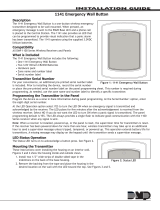Page is loading ...

INSTALLATION GUIDE
1139 Bill Trap Transmitter
Description
The 1139 Bill Trap is a wireless transmitter designed to
provide a silent alarm in retail and banking cash drawers
by trapping one bill below a stack of bills. When the
trapped bill is removed, a panic alarm is sent. To reduce
the possibility of a false alarm, a delay can be programmed
to provide time to replace the bill should it be accidentally
removed.
Compatibility
All DMP 1100 Series Wireless Receivers and Panels
Included Components
• One Bill Trap with DMP wireless transmitter installed
• Two CR2450 3.0V lithium coin cell batteries
• Velcro mounting strip
Transmitter Serial Number
For your convenience, an additional pre‑printed serial number label is included. Record the serial number or place
the pre‑printed serial number label on the panel programming sheet. This number is required during programming.
As needed, use the zone name and number label to identify a specic transmitter.
Programming the Bill Trap in the Panel
Refer to the panel programming guide as needed. Program the device as a zone in Zone Information during panel
programming. At the Serial Number prompt, enter the eight‑digit serial number. Continue to program the zone as
directed in the panel programming guide.
Note: When a receiver is installed, powered up, or the panel is reset, the supervision time for transmitters is
reset. If the receiver has been powered down for more than one hour, wireless transmitters may take up to an
additional hour to send a supervision message unless tripped or powered up. This operation extends battery life for
transmitters. A missing message may display on the keypad until the transmitter sends a supervision message.
Application Example
When using an 1139 Bill Trap, program the zone as a Panic type zone. XR150/XR550 Series and XR100/XR500 Series
panels provide a Retard Delay that can be programmed on Panic type zones. In System Options set a Retard Delay
time from 1 to 250 seconds. This provides time to replace an accidentally removed bill and avoid a false alarm. Also,
an output can be assigned to the zone with the action set to Follow. When connected to a preprogrammed DVR and
camera, and the panic zone is tripped, the camera can increase the frame speed.
Selecting the Proper Location (LED Survey Operation)
Note: Refer to Figure 2 to remove the 1139 housing base and Figure 3 for the
1139 PCB LED location.
The 1139 Bill Trap provides a survey capability to allow one person to conrm
transmitter communication with the receiver while the cover is removed.
The 1139 Bill Trap PCB Red Survey LED turns on whenever data is sent to the
receiver then immediately turns off when the receiver acknowledgement is
received. Inserting and removing a piece of paper or a bill is a convenient
way to send data to the receiver to conrm operation. When the paper or
bill is inserted, the LED blinks once to indicate proper operation. When the
transmitter does not receive an acknowledgement from the receiver the LED
remains on for about 8 seconds or ashes multiple times in quick succession
to let you know communication is not established. Relocate the transmitter
or receiver until the LED immediately turns off indicating the transmitter
and receiver are communicating properly. Proper communication between
the transmitter and receiver is veried when for each insertion and removal,
the LED blinks immediately on and immediately off. Repeat this test to conrm
ve separate consecutive LED blinks. Any indication otherwise means proper
communication has not been established.
Figure 1: 1139 Bill Trap
Bill Trap Housing Base
Bill Trap Transmitter Housing
Bill Trap -
Slide one end of bill
underneath clip
to hold in place.
Bill Trap Housing
Base Mounting
Screw Locations
Figure 2: Bill Trap Base and
Mounting Screw Locations

Digital Monitoring Products 1139 Wireless Bill Trap Installation Guide
2
Installing the Bill Trap
Slide a bill into the Bill Trap on the 1139 as shown in Figure 1. The 1139 Bill
Trap unit easily slides into a bill slot of a cash drawer. Place additional bills
above the trapped bill for standard cash drawer operation.
Installing or Replacing the Battery
Observe polarity when installing the battery. Use only 3.0V lithium batteries,
DMP Model CR2450, or a Sony CR2450 battery from a local retail outlet.
Note: When setting up a wireless system, it is recommended to program
zones and connect the receiver before installing batteries in the transmitters.
To install or replace batteries or view the LED ash:
1. Use a Phillips screwdriver to remove the three screws holding the base
and housing together. See Figure 2.
2. Gently lift the PCB out of the housing.
3. If installed, push and slide each old battery out of the holder in the
direction of the arrow to remove it. See Figure 3.
4. Verify the positive side of the new battery is up.
5. Slide each new 3.0V lithium battery into its holder and push into place.
6. Gently slide the PCB back into the housing making sure the lever alarm
switch is in position to activate. See Figure 4.
7. Use a Phillips screwdriver to replace the base onto the housing.
8. Slide the bill trap back into the cash drawer.
Caution: Properly dispose of used batteries. Do not recharge, disassemble, heat above 212°F (100°C), or
incinerate. Risk of re, explosion, and burns.
Battery Life Expectancy
Typical battery life expectancy for DMP Model 1139 Bill Trap is 1 year. DMP wireless equipment uses two‑way
communication to extend battery life.
The following situations can reduce battery life expectancy:
• If a receiver is unplugged, too far away, or not installed.
Note: Transmitters continue to send supervision messages until a receiver returns an acknowledgement.
• Frequent transmissions, such as constant removing and replacing the trapped bill.
• When installed in extreme hot or cold environments.
The following situation can extend battery life expectancy:
• Extend transmitter supervision time in panel programming.
• Infrequent transmission trips.
Lever Alarm
Switch
Universal
Antenna
CR2450 Coin Cell Batteries
with Positive Side Up
Push the Battery
Edge to Slide
Battery Out
Red LED
Figure 3: Bill Trap Battery Locations
Correct
Lever Alarm
Switch Locationvv
Red LED
Antenna
Incorrect
Lever Alarm
Switch Locationv
Red LED
Antenna
Figure 4: Lever Alarm Switch Location Detail

1139 Wireless Bill Trap Installation Guide Digital Monitoring Products
3
FCC Information
This device complies with Part 15 of the FCC Rules. Operation is subject to the following two conditions:
(1) This device may not cause harmful interference, and
(2) this device must accept any interference received, including interference that may cause undesired operation.
The antenna used for this transmitter must be installed to provide a separation distance of at least 20 cm from all
persons. It must not be co‑located or operated in conjunction with any other antenna or transmitter.
Changes or modications made by the user and not expressly approved by the party responsible for compliance could
void the user’s authority to operate the equipment.
Note: This equipment has been tested and found to comply with the limits for a Class B digital device, pursuant
to part 15 of the FCC Rules. These limits are designed to provide reasonable protection against harmful
interference in a residential installation. This equipment generates, uses and can radiate radio frequency
energy and, if not installed and used in accordance with the instructions, may cause harmful interference
to radio communications. However, there is no guarantee that interference will not occur in a particular
installation. If this equipment does cause harmful interference to radio or television reception, which can be
determined by turning the equipment off and on, the user is encouraged to try to correct the interference by
one or more of the following measures:
‑ Reorient or relocate the receiving antenna.
‑ Increase the separation between the equipment and receiver.
‑ Connect the equipment into an outlet on a circuit different from that to which the receiver is connected.
‑ Consult the dealer or an experienced radio/TV technician for help.

800-641-4282
INTRUSION • FIRE • ACCESS • NETWORKS
www.dmp.com 2500 North Partnership Boulevard
Designed, Engineered and
Assembled in U.S.A. Springeld, Missouri 65803-8877
LT-0693 © 2016 Digital Monitoring Products, Inc.
16404
Specications
Battery
Life Expectancy 1 year using 2 batteries
Type 3.0V lithium CR2450
See Battery Life Expectancy for details.
Transmit condition Alarm
Dimensions
5.375” H x 2.625” W x .625” D
Color Ivory
Housing material Flame retardant ABS
Patents
U. S. Patent No. 7,239,236
Compatibility
1100D Wireless Receivers
1100DH Wireless High Power Receivers
1100DI Wireless In‑line Receivers
1100X Wireless Receivers
1100XH Wireless High Power Receivers
XTLC Panels with an integrated wireless receiver
XTLN Panels with an integrated wireless receiver
XT50 Series Panels with an integrated wireless receiver
XTLplus Series Panels
Certications
FCC Part 15 Registration ID CCKPC0103
/

















